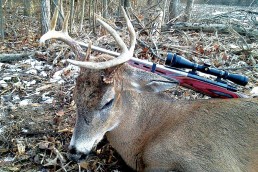Supersonic?
SHARE THIS POST
Q: Can a bullet incapacitate or kill a deer with a near miss?
A: Pro Hunter Keith Warren and I say, “Yes.”
December, 2014: Keith Warren was testing the power of a .50-caliber BMG sniper rifle on a whitetail deer hunt. He crushed a doe, but after further inspection and slow-motion camera study, they realized Keith hadn’t made actual contact after all. In fact, the supersonic force of the passing projectile caused enough vacuum when breaking the sound barrier that it sucked the eyes right out of the doe’s skull. It’s on film, folks.
Supersonic travel is a rate of travel of an object that exceeds the speed of sound (about 760 mph, known as Mach 1). Sounds are traveling vibrations in the form of pressure waves in an elastic medium. Most modern firearm bullets approach and often exceed Mach 3.
Sonic booms can create an enormous amount of energy, sounding similar to an explosion or thunderclap to the human ear. But it only affects observers that are positioned at a point that intersects a region in the shape of a geometrical cone behind the object. As the object moves, so does the conical region behind it. And when the cone passes over the observer, the boom is briefly experienced.
Now, for years, some war vets have made claims that the .50-caliber round could kill a man or injure limbs with a close miss. Many ammo techs have disproved this theory with their own video testing, where stacked plastic Solo cups set in a pyramid didn’t rattle or topple, even after direct hits. They say jet airplanes can’t even cause that severe of damage with pulling much higher decibels.
Are you enjoying this post?
You can be among the first to get the latest info on where to go, what to use and how to use it!
But can a supersonic shockwave “ricochet” create a slight sonic boom or vacuum that causes temporary disabling of a human or deer? Some say it could bust your eardrum. While mine never burst, I did experience severe trauma that lead to permanent hearing loss in 2009, when a similar situation occurred amongst a ring of trees surrounding a small farm field and myself. Shelling a doe on full sprint, the reverberation of three shotgun blasts off those oaks had me bent over, holding my head in pain.
TKO
Now, while I never checked my buck’s skull for damage, I can without a doubt attest to knocking out a deer on a near miss with a .35 Winchester Short Mag round in 2013. The buck crossed a mowed lane between two tall walls of woods, say 25 yards apart, on state game land in Huntington, Indiana. The perceived hit lifted the cervid off its feet and flipped itself backwards mid-air, crashing down on its back and knocking itself out. Talk about shock and awe.
Mistaking him for dead, I waited a few minutes before pursuing the deer 60 yards away. Then, like a resurrection, the buck stood up and staggered like a drunk down the lane as I watched in disbelief. Curious to why he would pick an open corridor to a wooded exodus, I granted him an ample 45-yard trot before ripping off another round to flatten him for good.
Upon inspection, I only found the second bullet entry and exit in a quartering away trajectory. Where the heck was the initial shot wound? I called my gun maker, Dexter Lutter, who was intrigued by the story and had only heard of this phenomenon. Though fascinated with my online research, I wouldn’t find another example of this kind of shockwave incapacitation ‘til Warren’s encounter in 2014.
I can’t begin to intelligently disseminate the science and physics behind the theory, and I’d lose my audience in three sentences of formulations anyways. Essentially, my rushed shot missed the buck, but the conical wave of sound vibrations did not, rendering the animal senseless. Despite naysayers, I know what I witnessed that November day, and believe that a supersonic boom that can prostrate an animal for a short period of time, if not kill it.
MWO
SHARE THIS POST
You may also like...
Did you enjoy this post?
You can be among the first to get the latest info on where to go, what to use and how to use it!
Scott Cummings
Scott Cummings is an avid sportsman, educator and nationally published freelance outdoors writer and photographer. National Wild Turkey Federation and Wildlife Forever named him their 2013 and 2014 Conservation Educator of the Year for his work in and out of the classroom.



